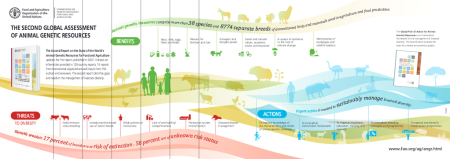- The latest meta-analysis of organic agriculture says it can feed the world.
- The latest update on saving the wild ginseng adds pretty much nothing to previous updates.
- The latest look at Aboriginal land burning says it did no damage.
- The latest study of insects as feed says they’re good for you. Still no word on whether they’re good.
- Not sure whether I’ve ever seen a study linking biotech corn for biofuels with the abandonment of rotation, but it makes sense. And more.
- The latest investigation of early childhood nutrition still says it’s important.
- The latest Italian food scam involves painting olives.
- The latest pean to crop wild relatives says it’s still about control, man.
- The latest report on dams again says you have to be careful.
Nibbles: History edition
- No, I don’t think the history of potatoes is at an end, but I know what they mean.
- The history of rubber in pics.
- The history of the wheat dwarfing gene.
- Svalbard makes history.
- Sicily goes back into its history for its daily bread.
- Another foothold in history for Gary Nabhan.
- History, shmistory, we need to look forward. Biohacking is the future of food. Say twelve year olds.
Brainfood: Animal genomics, Konjac diversity, New wild cassava, New wild cowpeas, Saline breeding, Land sparing, Sorghum diversity
- The impact of whole genome sequence data to prioritise animals for genetic diversity conservation. Relationships from whole genome sequence data were better than SNPs at preserving rare variants when selecting individuals for inclusion in a genebank.
- Genetic variation in wild populations of the tuber crop Amorphophallus konjac (Araceae) in central China as revealed by AFLP markers. Diverse, endangered, somewhat isolated populations, with some geographic structuring.
- Manihot allemii sp. nov. (Euphorbiaceae s.s.) with entire and unlobed leaves from northern Brazil, with notes about foliar anatomy. It never ends.
- Novel Genetic Resources in the Genus Vigna Unveiled from Gene Bank Accessions. Japan sorts out its genebank. It really does never end.
- Uncoupling of sodium and chloride to assist breeding for salinity tolerance in crops. We’ve been breeding for exclusion of Na+, but we should be breeding for tolerance to it.
- How can higher-yield farming help to spare nature? By making sure that lower prices and/or higher profits don’t encourage agricultural expansion.
- Seed exchange networks, ethnicity, and sorghum diversity. Culture drives diversity.
AnGR report ready for prime time
Some 17 percent (1,458) of the world's farm animal breeds are currently at risk of extinction: #UNFAO's new #AnimalGenetics report
— Food and Agriculture Organization (@FAO) January 27, 2016
The second report on the State of the World’s Animal Genetic Resources for Food and Agriculture is being launched by FAO today. And you can watch it live! In a few minutes…
Brainfood: Lima bean cyanide, Hybrid powdery mildew, Amaranth core, Cotton core, Tibetan sheep, Water buffalo history
- Herbivore damage induces a transgenerational increase of cyanogenesis in wild lima bean (Phaseolus lunatus). Lamarck lives.
- Hybridization of powdery mildew strains gives rise to pathogens on novel agricultural crop species. Hybrid crop gives rise to hybrid pathogen.
- Trait-specific Amaranth Germplasm—Potentialities to Combat Climate Change. From 5,804 accessions to 623 really useful ones.
- Genetic diversity of the two commercial tetraploid cotton species in the Gossypium Diversity Reference Set. 100 SSRs on 2000 accessions yield really confusing results.
- Genetic diversity estimates point to immediate efforts for conserving the endangered Tibetan sheep of India. Only 250 individuals, but still some genetic diversity. But for how long?
- Water Buffalo Genomic Diversity and Post-Domestication Migration Routes. Two domestications, and some unexpected migration routes.
